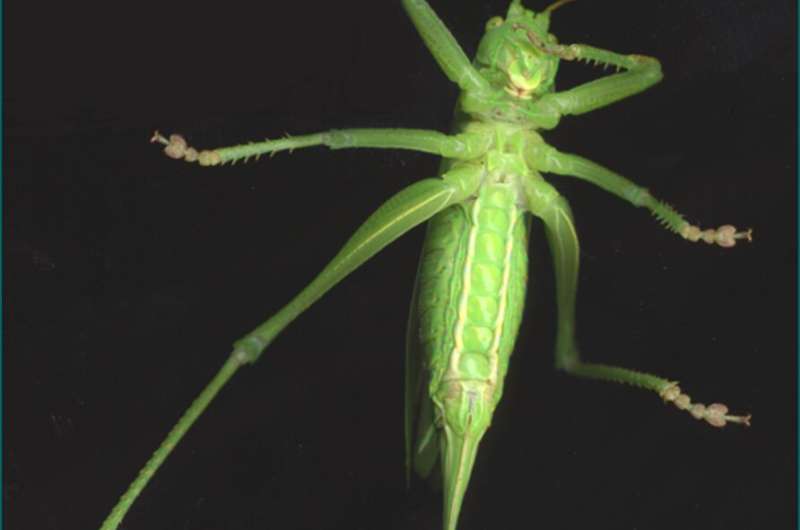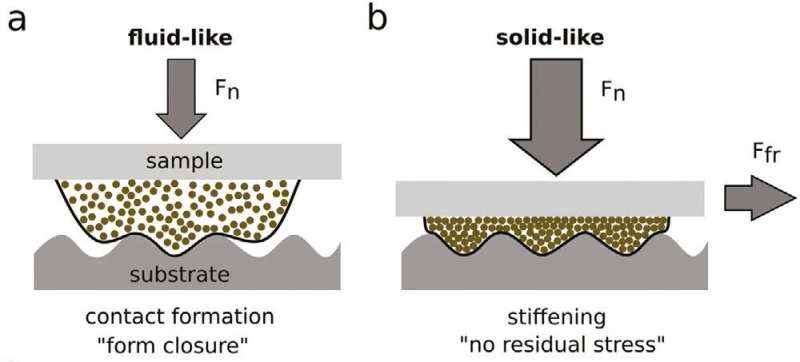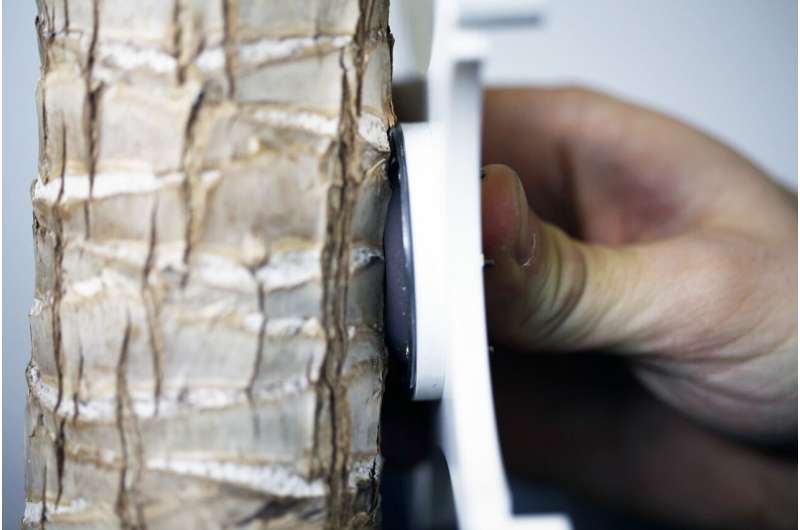Team develops multisurface adhesion system modeled on grasshopper's feet

In their everyday lives, insects often have to cope with both rough and smooth as well as sticky surfaces. They achieve a firm grip through special hooks or tiny hairs on their feet. While these different requirements are not a problem for many insects, technical applications are less flexible. They are usually specifically developed for a particular application—such as summer or winter tires, for example—and are not able to adapt to different surfaces. Inspired by the special structure of grasshopper's feet, an interdisciplinary research team at Kiel University (CAU) has now developed an artificial frictional system that works on a wide variety of surfaces. Their combination of a soft silicone membrane, filled with fine-grained granulate, adapts itself to almost any surface and creates a firm grip under slight pressure. The simple production method also enables industrial applications, as reported by the research team in the current issue of the scientific journal Advanced Materials Interfaces.
Switching between soft and hard material properties
A firm grip requires a good contact surface as well as a stable transmission of force at the same time. "In order to stick to different surfaces, we must switch between the behavior of soft and hard materials, which is actually a contradiction in terms," explained Stanislav Gorb, Professor of Functional Morphology and Biomechanics at the CAU. While soft materials allow a large contact area with the wide variety of surface textures, hard materials enable an optimal transmission of force. Therefore, the bionics expert and his team sought a way to switch between the two material properties. In addition, they wanted a solution simple and economical to produce, so that it can also be used for industrial applications.
They were inspired by the special feet of grasshoppers, which are characterized by small, cushion-like appendages. In previous research, Gorb and his team was able to show that these cushions are encased with a rubber-like film, which provides good frictional and adhesive contact with the surface. On the other hand, the inside of the cushions consists of particularly stable fibers which can transmit a great deal of force. Recreating such a fibrillar structure would be too time consuming and too expensive for industrial applications, however.

Now, the Kiel research team has demonstrated a similar effect for granulate, i.e. a fine-grained material. To do so, they used a principle of so-called "jamming transition." "You know that from vacuum-packed coffee: the coffee powder is compressed and forms a dense mass, as hard as a rock. When the packet is opened for the first time, the powder becomes loose, and thus behaves quite differently, like a fluid," described Halvor Tramsen, who along with Lars Heepe is one of the physicists in the research team.
High frictional forces on smooth, structured and dirty surfaces
They encased the granulate by a flexible membrane cover and tested the friction properties of their "granular cushion" GMFP (granular medium friction pad) on smooth, structured and dirty surfaces. Thanks to the soft and stretchable membrane, the cushion attached perfectly to the various surfaces. The scientists then exerted pressure on the cushion, which compacted the granulate inside, and solidified the whole cushion. This stiffness and the large contact area with the surface together generate high frictional forces through which the cushion can no longer be moved. The cushion displayed similarly high friction on all three types of test surfaces.

How the frictional principle of the granulate cushion works on other surfaces is illustrated by a model developed by Professor Alexander Filippov, a theoretical physicist and Georg Forster Research Fellow in the Kiel working group. His numerical model also allowed the interaction of granulate and membrane to be tested for other materials and particle sizes.
"In our prototype, we used elastic silicone for the cover and actually filled it with dried coffee grounds," explained Gorb. Due to their size and their rough shape, these particles get entangled with each other very easily, and the jamming transition effect, i.e. the switch between the properties of soft and hard materials, works particularly well. In principle, it is certainly conceivable to also use dried coffee grounds for industrial applications with recycling benefits. After all, this coffee residue is readily available, free of pollutants and cheap, said Gorb. Research on other granular materials and membranous surfaces is already planned.
More information: Halvor T. Tramsen et al. Maximizing Friction by Passive Jamming, Advanced Materials Interfaces (2020). DOI: 10.1002/admi.201901930
Provided by Kiel University





















